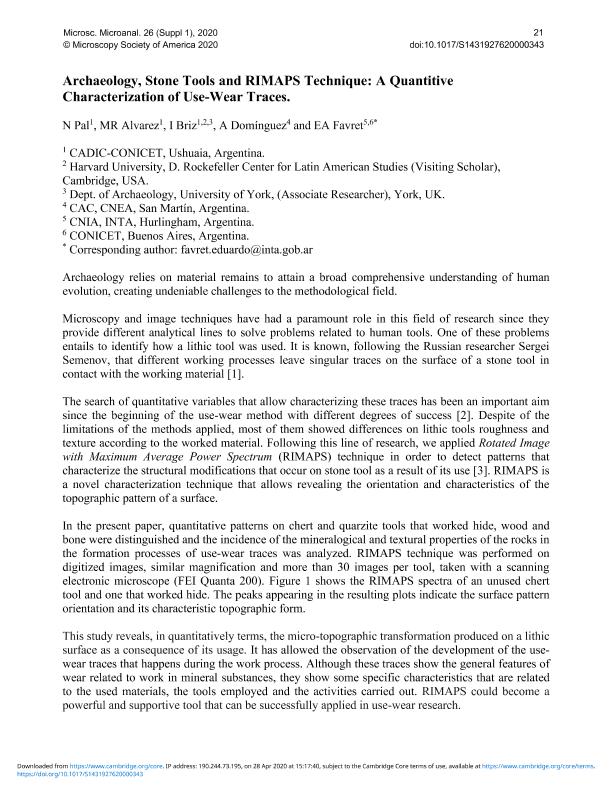Mostrar el registro sencillo del ítem
dc.contributor.author
Pal, Nélida Marcela

dc.contributor.author
Alvarez, Myrian Rosa

dc.contributor.author
Briz Godino, Ivan

dc.contributor.author
Domínguez, A.
dc.contributor.author
Favret, Eduardo Alfredo

dc.date.available
2021-09-13T17:22:07Z
dc.date.issued
2020-04-28
dc.identifier.citation
Pal, Nélida Marcela; Alvarez, Myrian Rosa; Briz Godino, Ivan; Domínguez, A.; Favret, Eduardo Alfredo; Archaeology, stone tools and RIMAPS technique: A quantitive characterization of use-wear traces; Cambridge University Press; Microscopy & Microanalysis; 26; S1; 28-4-2020; 21-22
dc.identifier.issn
1431-9276
dc.identifier.uri
http://hdl.handle.net/11336/140213
dc.description.abstract
Archaeology relies on material remains to attain a broad comprehensive understanding of human evolution, creating undeniable challenges to the methodological field. Microscopy and image techniques have had a paramount role in this field of research since they provide different analytical lines to solve problems related to human tools. One of these problems entails to identify how a lithic tool was used. It is known, following the Russian researcher Sergei Semenov, that different working processes leave singular traces on the surface of a stone tool in contact with the working material. The search of quantitative variables that allow characterizing these traces has been an important aim since the beginning of the use-wear method with different degrees of success. Despite of the limitations of the methods applied, most of them showed differences on lithic tools roughness and texture according to the worked material. Following this line of research, we applied Rotated Image with Maximum Average Power Spectrum (RIMAPS) technique in order to detect patterns that characterize the structural modifications that occur on stone tool as a result of its use. RIMAPS is a novel characterization technique that allows revealing the orientation and characteristics of the topographic pattern of a surface. In the present paper, quantitative patterns on chert and quarzite tools that worked hide, wood and bone were distinguished and the incidence of the mineralogical and textural properties of the rocks in the formation processes of use-wear traces was analyzed.
dc.format
application/pdf
dc.language.iso
eng
dc.publisher
Cambridge University Press

dc.rights
info:eu-repo/semantics/openAccess
dc.rights.uri
https://creativecommons.org/licenses/by-nc-sa/2.5/ar/
dc.subject
USE-WEAR
dc.subject
LITHICS
dc.subject
MICROSCOPY
dc.subject
RIMAPS
dc.subject.classification
Arqueología

dc.subject.classification
Historia y Arqueología

dc.subject.classification
HUMANIDADES

dc.title
Archaeology, stone tools and RIMAPS technique: A quantitive characterization of use-wear traces
dc.type
info:eu-repo/semantics/article
dc.type
info:ar-repo/semantics/artículo
dc.type
info:eu-repo/semantics/publishedVersion
dc.date.updated
2021-07-30T18:08:55Z
dc.journal.volume
26
dc.journal.number
S1
dc.journal.pagination
21-22
dc.journal.pais
Reino Unido

dc.journal.ciudad
Cambridge
dc.description.fil
Fil: Pal, Nélida Marcela. Consejo Nacional de Investigaciones Científicas y Técnicas. Centro Austral de Investigaciones Científicas; Argentina
dc.description.fil
Fil: Alvarez, Myrian Rosa. Consejo Nacional de Investigaciones Científicas y Técnicas. Centro Austral de Investigaciones Científicas; Argentina
dc.description.fil
Fil: Briz Godino, Ivan. Consejo Nacional de Investigaciones Científicas y Técnicas. Centro Austral de Investigaciones Científicas; Argentina. Harvard University; Estados Unidos. University of York; Reino Unido
dc.description.fil
Fil: Domínguez, A.. Comisión Nacional de Energía Atómica; Argentina
dc.description.fil
Fil: Favret, Eduardo Alfredo. Comision de Investigaciones Cientificas de la Provincia de Buenos Aires. Laboratorio de Acustica y Luminotecnia.; Argentina. Consejo Nacional de Investigaciones Científicas y Técnicas; Argentina
dc.journal.title
Microscopy & Microanalysis

dc.relation.alternativeid
info:eu-repo/semantics/altIdentifier/url/https://www.cambridge.org/core/product/identifier/S1431927620000343/type/journal_article
dc.relation.alternativeid
info:eu-repo/semantics/altIdentifier/doi/https://doi.org/10.1017/S1431927620000343
Archivos asociados
